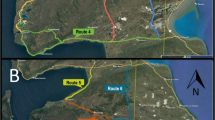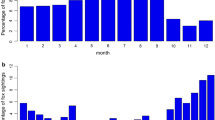Abstract
Increases in red foxVulpes vulpes (Linnaeus, 1758) numbers and densities have been found in all European countries involved in the rabies vaccination program. In Poland, the number of foxes has increased steadily since the 1990s. Between 1999–2000, the average density of foxes reached 1.3–2 ind./km2 in some parts of the country. The aim of the study was to estimate the change in fox population densities in central Poland during 1980–2006, and to assess the effect these changes have had on the spatial distribution of natal dens, mean numbers of cubs observed at occupied dens and the sedentary/nomadic fox ratio. Estimations of fox population density and numbers were based on three methods: (1) counts of tracks in snow, (2) locations of natal dens and counts of cubs, and (3) the battue (driving) method. The three methods of assessment were used continuously in our study area over a period of 25 years. Average yearly results were analysed and comparisons made between the periods before and after implementation of the anti-rabies vaccination. The results obtained with all three methods show a significant increase in the fox population, when the two analysed periods are compared. Increases in fox population densities correlated with increased numbers of breeding sites being located outside forests, from only single ones in the 1980s to 24% of the total in 2005. The average number of cubs per occupied den decreased significantly (by 11%) in comparison with before the anti-rabies vaccination period. The great increase (more than 100%) in fox numbers observed using the battue (driving) method suggest, that nomadic animals can form an important part of winter population in our study area.
Similar content being viewed by others
References
Allen S. H. and Sargeant A. B. 1993. Dispersal patterns of red foxes relative to population density. The Journal of Wildlife Management 57: 526–533.
Aubert M., Vuillaume P. and Masson E. 1993. La vaccination orale des renards est efficace même quand leurs populations augmentent. Bulletin épidémiologique de la rage animale en France 23: 1–4.
Bailey N. T. J. 1995. Statistical methods in biology. Cambridge University Press, Cambridge: 1–200.
Breitenmoser U., Müller U., Kappeler A. and Zanoni R. G. 2000. Die Endphase der Tollwut in der Schweiz. Schweizer Archiv fur Tierheilkunde 142: 447–457.
Bresiński W. and Panek M. 2000. [The condition of the fox population in Poland at the end of the nineties (monitoring results)]. [In: Zwierzyna drobna jako element bioróżnorodnooeci oerodowiska przyrodniczego. Materiały II Krajowej Konferencji, Włocławek, 7–9.09.2000. S. Kubiak, ed]. Włocławskie Towarzystwo Naukowe, Włocławek: 163–171. [In Polish]
Chautan M., Portier D. and Artois M. 2000. Role of rabies in recent demographic changes in red fox (Vulpes vulpes) populations in Europe. Mammalia 64: 391–410.
Contesse P., Hegglin D., Gloor S., Bontadina F. and Deplazes P. 2004. The diet of urban foxes (Vulpes vulpes) and the availability of anthropogenic food in the city of Zurich, Switzerland. Mammalian Biology 69: 81–95.
Côté I. M. and Sutherland W. J. 1997. The effectives of removing predators to protect bird populations. Conservation Biology 11: 395–405.
Dudziński W. 1988. Wintering grounds of the partridge. [In: The grey partridge in Europe. Proceedings of an International Symposium held in Kikol, Poland, October 1985]. Polish Hunting Association, Warsaw: 161–197.
Dzięciołowski R., Wasilewski M., Przypaoeniak J. and Wawrzyniak P. 1999. Recent changes in European hare (Lepus europaeus) population dynamics in Poland. [In: Proceedings of the International Union of Game Biologists. XXIVth Congress, C. Thomaidis and N. Kypridemos, eds]. Hunting and Target Shooting Magazine, Gundogs and Hunting Magazine: 401–408.
Gloor S., Bontadina F., Hegglin D., Deplazes P. and Breitenmoser U. 2001. The rise of urban fox populations in Switzerland. Mammalian Biology 66: 155–164.
Gołdyn B., Hromada M., Surmacki A. and Tryjanowski P. 2003. Habitat use and diet of the red foxVulpes vulpes in an agricultural landscape in Poland. Zeitschrift für Jagdwissenschaft 49: 191–200.
Goszczyński J. 1985. The effect of structural differentiation of an ecological landscape on predator-prey interactions. Treatises and Monographs. SGGW-AR, Warsaw 46: 1–80. [In Polish with English summary]
Goszczyński J. 1989. Population dynamics of the red fox in central Poland. Acta Theriologica 34: 141–154.
Harris S. and Rayner J. M. V. 1986. Urban fox (Vulpes vulpes) population, estimates and habitat requirements in several British cities. Journal of Animal Ecology 55: 575–591.
Hofer S., Gloor S., Müller U., Mathies A., Hegglin D. and Deplazes P. 2000. High prevalence ofEchinococcus multilocularis in urban red foxes (Vulpes vulpes) and voles (Arvicola terrestris) in the city of Zürich, Switzerland. Parasitology 120: 135–142.
Holmala K. and Kauhala K. 2006. Ecology of wildlife rabies in Europe. Mammal Review 36: 17–36.
Jackowski M. 1999. [Numbers, density and spatial distribution of the red fox and badger in Rogów]. MSc thesis, Department of Forest Protection and Ecology, Warsaw Agricultural University, Warsaw: 1–36. [In Polish]
Jasja J. A., Dekker J. J. A., Stein A. and Heitköning I.M. A. 2001. A spatial analysis of the population of the red fox (Vulpes vulpes) in the Dutch coastal dune area. Journal of Zoology, London 255: 505–510.
Juszko S. 2005. [The impact of predation on brown hare mortality in central Poland]. PhD thesis, Department of Forest Protection and Ecology, Warsaw Agricultural University, Warsaw: 1–81. [In Polish]
Lach M. 1991. [Reproduction and density of the red fox in the Rogów area]. MSc thesis, Department of Game Management and Forest Zoology, Warsaw Agricultural University, Warsaw: 1- 35. [In Polish]
Kamieniarz R. 2006. [Do fox kill roe deer?]. Łowiec Polski 6: 20–22. [In Polish]
Kauhala K., Holmala K., Lammers W. and Schregel J. 2006. Home ranges and densities of medium-sized carnivores in south-east Finland, with special reference to rabies spread. Acta Theriologica 51: 1–13.
König A. 2008. Fears, attitudes and opinions of suburban residents with regards to their urban foxes. European Journal of Wildlife Research 54: 101–109.
Misiorowska M. 2005. [Red fox (Vulpes vulpes) number and spatial distribution in LZD Rogów area]. MSc thesis, Department of Forest Protection and Ecology, Warsaw Agricultural University, Warsaw: 1–57. [In Polish]
Panek M. and Bresiński W. 2002. Red foxVulpes vulpes density and habitat use in a rural area of western Poland at the end of the 1990s, compared with the turn of the 1970s. Acta Theriologica 47: 433–442.
Panek M., Kamieniarz R. and Bresiński W. 2006. The effect of experimental removal of red foxesVulpes vulpes on the spring density of brown haresLepus europaeus in western Poland. Acta Theriologica 51: 187–193.
Pielowski Z. 1976. The role of foxes in the reduction of the European hare population. [In: Ecology and management of European hare populations. Z. Pielowski and Z. Pucek, eds]. Państwowe Wydawnictwo Rolnicze i Leoene, Warszawa: 135–148.
Pucek Z., Bobek B., Łabucki L., Miłkowski L., Morow K. and Tomek A. 1975. Estimates of density and number of ungulates. Polish Ecological Studies 1: 121–136.
Reynolds J. C., Goddard H. N. and Brockless M. H. 1993. The impact of local fox (Vulpes vulpes) removal on fox population at two sites in southern England. Giber Faune Sauvage 10: 319–334.
Saunders G., White P. C. L. and Harris S. 1997. Habitat utilisation by urban foxes (Vulpes vulpes) and the implications for rabies control. Mammalia 61: 497–510.
Trewhella W. J., Harris S. and McAllister F. E. 1988. Dispersal distance, home range size and population density in the red fox (Vulpes vulpes): a quantitative analysis. Journal of Applied Ecology 25: 423–434.
Tryjanowski P. 2000. Changes in breeding bird populations of some farmland birds in W. Poland in relation to changes in crop structure, weather conditions and number of predators. Folia Zoologica 49: 305–315.
Voigt D. R. and Macdonald D. W. 1984. Variation in the spatial and social behaviour of the red fox,Vulpes vulpes. Acta Zoologica Fennica 171: 261–265.
Vos A. C. 1995. Population dynamics o the red fox (Vulpes vulpes) after the disappearance of rabies in county Garmisch-Partenkirchen, Germany, 1987–1992. Annales Zoologici Fennici 32: 93–97.
Vos A. C. 2003. Oral vaccination against rabies and behavioural ecology of the red fox (Vulpes vulpes). Journal of Veterinary Medicine, Series B 50: 477–483.
Wasilewski M. 1986. Population dynamics of pheasants near Rogów, Central Poland. Ekologia Polska 34: 669–680.
Wasilewski M. 1991. Population dynamics of the European hareLepus europaeus Pallas, 1778 in Central Poland. Acta Theriologica 36: 267–274.
Zimen E. 1984. Long range movements of the red fox,Vulpes vulpes L. Acta Zoologica Fennica 171: 267–270.
Author information
Authors and Affiliations
Additional information
Asscociate editor was Andrzej Zalewski.
Rights and permissions
About this article
Cite this article
Goszczyński, J., Misiorowska, M. & Juszko, S. Changes in the density and spatial distribution of red fox dens and cub numbers in central Poland following rabies vaccination. Acta Theriol 53, 121–127 (2008). https://doi.org/10.1007/BF03194245
Received:
Accepted:
Issue Date:
DOI: https://doi.org/10.1007/BF03194245




